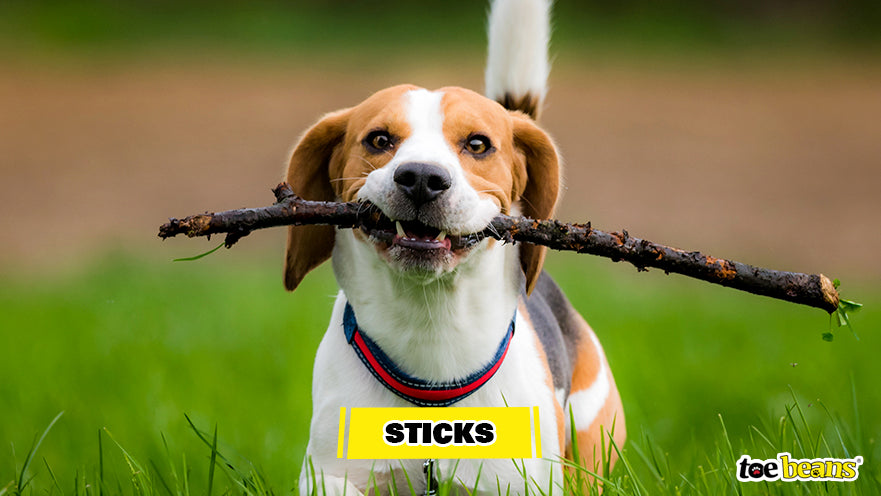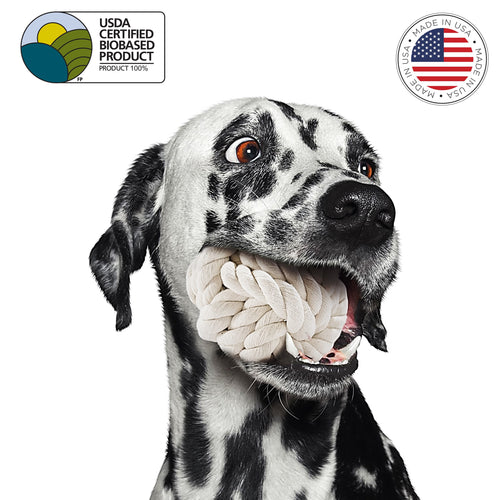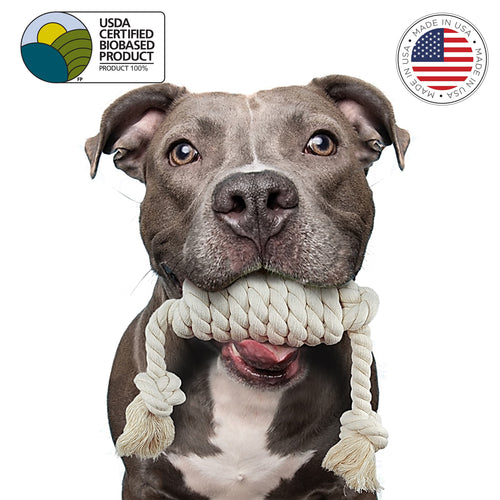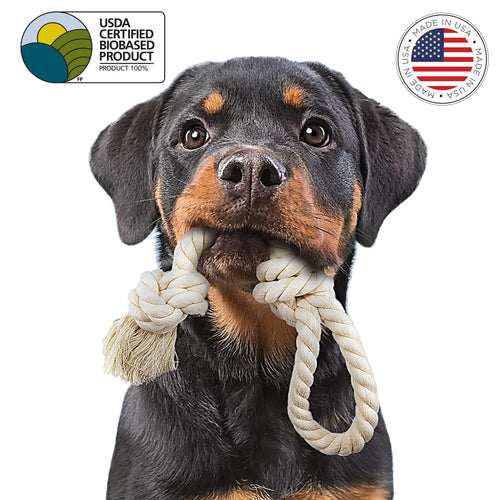Your Cart is Empty
Free 2-5 day delivery | No minimum purchase required
Free 2-5 day delivery | No minimum purchase required
Shop
Learn
What Types of Dog Toys Can Damage Your Dog's Teeth?
 by K Marie Alto Updated
12 min read
by K Marie Alto Updated
12 min read

You take care of your own teeth. You brush them daily, you floss, you maybe use mouthwash, and you avoid chewing on rocks, wood, and bones.
Unfortunately your fur baby doesn't have the same luxuries. They can't brush their own teeth, nor can they use mouthwash. Of all the dog toys in your house, do you know what types of dog toys can damage your dog's teeth?
Some of your dog's favorite things to play with are sticks and bones. As a result, it's no surprise, that your dog teeth are prone to damage.
Did you know, that many chew toys can be really bad for your dog's teeth?
It's true. In fact, many of the toys commonly seen in pet stores and department stores are terrible for your dog's oral health. They can damage teeth, wear them down, and in some cases even break them.
If you are looking for more educational guides on dog toys, make sure not to miss the read further section at the bottom. I have written extensively about this topic! Alternatively, you can visit my blog and search by topic. Spoiler alert: it is loaded with useful pet parent resources.
As you may imagine, not all chews are created equal; so let’s chat about the worst offenders.
Table of Contents
Bones Can Damage Teeth
"Give the dog a bone" might be part of a common nursery rhyme, but it's terrible advice for pet parents. Many pups love gnawing them to bits when they can, but bones are one of the most dangerous chews you can give your pup. Here's why:
- Bones are hard. They wear away at teeth the same way teeth wear away at bones. Fragile teeth or teeth with fractures or cavities can even break under the pressure.
- Ring-shaped bones can get stuck between and behind the teeth, wedging themselves in place and potentially even requiring anesthesia to remove.
- Bones aren't easily digestible, so when your fur baby breaks off and swallows pieces, they can build up and cause an intestinal blockage.
- Some bones, poultry bones, in particular, can fracture and shatter into sharp shards that can cut gums and the inside of the mouth, and if swallowed, can lacerate and puncture the digestive tract.
Watch this 3 minute video with Dr. Margaret Smith, DVM- Dentistry Veterinary Specialist at VCA Animal Hospitals about giving bones to dogs.
Should I Feed My Dogs Real Bones?
You may have heard that fresh bones from the butcher are softer and thus better for your fur baby.
While that might be true, it's like comparing different kinds of rocks. A diamond might be harder than slate, but both of them could break a tooth with ease.

Another common alternative to bones that are available at your local pet store is antlers. Unfortunately, antlers are also made out of bone (not to be confused with horns, which are made of keratin), so they're just as bad as any other kind of bone.
"A client presented an older farm dog that he noticed wasn't eating or acting normally. He did note that he hadn't noticed her pooping for about a week. When we radiographed her abdomen, her colon was completely blocked by bones. I am happy to say that after a very long process (over two hours) and the worst smelling substance you can imagine, we successfully cleared the blockage, and she went home a happy dog. Sadly, that isn't always the case." – Preventive Vet.
Hooves are another common alternative to bones. Unlike bones, they're made of keratin, which is softer. However, "softer" is still relative; just like you might fracture or wear down your teeth if you bite your nails, chewing on a hoof will also wear away your pup’s teeth.
"Hooves, antlers, and bones are a risk to any pet's health." - Phyllis DeGioia, Veterinary Partner Editor
Watch Out For Tennis Balls
Playing fetch with an old, cast-off tennis ball might be a time-honored tradition for most dog parents, but tennis balls can damage your pup's teeth too and can also be harmful to oral health. Tennis balls have two main problems; hardness isn't one of them, so what are they?
The first is actually the softness of the tennis ball. You've probably seen an old dog ball full of punctures, with a large crack, or even with pieces missing.
When a ball breaks down like that, your fur baby is more likely to pull apart and eat pieces of it.
Much like fragments of bone, your dog can't digest a tennis ball (who can?), and if they can avoid the inherent risk of chocking on the fragments, they can still cause an intestinal blockage, which if caught in time will require surgery to remove.

The second is the fuzz on the outside of the tennis ball. This fuzz is made out of synthetic plastics, which, while soft to the touch, are still abrasive.
Just like how your skin would feel raw and stripped if you rubbed a tennis ball against it for a while, that abrasiveness can wear away at your dog's tooth enamel.
More importantly, that fuzz gets dirty. Dog balls end up in the dirt and mud all the time, and the average pet parent doesn’t bother to wash them, because they’re just going to get dirty the next time you play a game of fetch, right? It's just a ball.
All of that dirt ends up trapped in the fuzz and makes it less like fuzz and more like sandpaper. It becomes even more abrasive and can grind away at teeth, leaving them sensitive, worn down, or even broken.
While unrelated to a dog's teeth, I could not help talking about a third reason why tennis balls pose a serious danger to your pup's overall health and well-being and that's the danger of buying dog toys made overseas.
In most cases, most pet parents are usually well aware of the risks involved in buying pet food coming from China.
However, oftentimes they are not aware that dog toys made in China expose their dogs to similar dangers. Tennis balls coming from China in particular have been found to contain deadly amounts of heavy metals.
According to big barker.com in 2009, the Ecology Center, a nonprofit environmental organization, tested hundreds of pet products for the presence of toxins, many of which were manufactured in China.
Almost half the tennis balls tested contained lead. The lettering on one of the balls had lead levels of 2,296 parts per million. By comparison, the legal maximum amount of lead allowed in children’s toys is 90 parts per million. The dog tennis ball contained more than 25 times that amount! In addition, the ball’s lead level is worse than the maximum-allowed dietary level in dogs. A dog that is overexposed to lead could experience vomiting, weight loss, anemia, seizures, and permanent neurological damage.- Big Barker.com
Further, according to the wildest.com,
Researchers discovered that tennis balls made specifically for pets were more likely to have lead than “sports” tennis balls...Curiously, none of the “sports” tennis balls tested contained any lead.
Our advice is that as a rule of thumb, you should avoid buying dog toys made overseas, period. In cases where you still have them laying around your house, you should get rid of them ASAP.
You may be tempted to keep them, after all, your dog has played with these toys for years now and h/se is still healthy. Which may give you some false sense of confidence. Perhaps, things have changed and my dog's toys are not contaminated, right?
Well, not really, keep in mind that it is the long term exposure to these metals and poisonous substances what poses the real risk to your dogs and relatives.
Sticks Can Wear Away Teeth
Who doesn't love a good photo of a dog carrying their favorite stick?
Who doesn't laugh at a small dog carrying a huge branch, or a pile of sticks accumulated by the neighborhood dogs, or a "stick library" at the local dog park?
Sticks are a time-honored fetch target, but are they harboring a sinister secret?
While a much softer option that bones, the truth is wood can also wear away or even break teeth.
Natural sticks are softer than something like hardwood furniture, sure, but "soft" wood is still wood.
More importantly, wood also splinters, and those sharp shards can be just as dangerous as shards of bone. Worse, in fact, because they can be harder to detect on medical imaging.

You also have the fact that sticks are irregular. With a bone or a ball, you can notice when a piece of it is missing that wasn't missing before.
With a stick, you never know if a sharp chunk of it is on the ground half a mile away, still connected to the tree the stick came from, or lodged in your fur baby's large intestine.
Small sticks and twigs can also get caught between teeth or in the jaws, causing discomfort, poking into gums, or even wedging the mouth open. This kind of damage can also lead to infection.
Careful With Nylon Chews and Toys
Nylon is a tough, durable plastic material that forms the base of a wide range of products, many meant for pet use and many more for human use.
It's a highly tough and durable plastic, so it's ideal for items that see a lot of wear and tear and need to stay more or less intact.

Unfortunately, they're a little too tough to be good as a dog chew. The plastic is a little too hard, harder than teeth, which means your dog chewing at them will more likely damage their mouth rather than the chew.
"Despite being touted as a safe chewing alternative, many nylon bones are made of hard materials that can damage your pet's teeth. Choose chew toys that are soft enough to indent when you press in your thumbnail, but hardy enough that your pet cannot chew them into pieces." – Cherry Hill Animal Hospital.
Nylon toys are especially prevalent. They solve a problem, after all. Many pet parents don't like to have to throw out their dog's favorite toys when they start to break down, but with softer and more fragile toys, that's exactly what needs to happen to keep the fur baby safe.
Nylon toys solve that by being virtually indestructible; at the very least they tend to take longer for the average dog to destroy.
The problem is that damage has to go somewhere. Repeated chewing, pressure, friction, and abrasion between two surfaces will always damage or wear away at one of them.
If the nylon toy isn't being damaged, what is? Unfortunately, it's usually your fur baby's mouth.
Ice Can Be Harmful
Ice isn’t inherently bad for dogs. After all, it’s just frozen water, and water is good for both you and your fur baby.
The trouble is, ice is hard as a rock – sometimes literally. As you’ve seen from just about everything else on this list, anything harder than a tooth can be bad news.
Ice cubes and large chunks of ice can be hard enough to crack or break teeth, especially if those teeth are already weakened by chewing on other hard substances or by decay.
Even frozen fruit or desserts could potential cause discomfort or harm. At a minimum, regularly chewing on ice will dull them.

Plus, as you might know from experience, if you have sensitive teeth, ice can be painful.
“While ice cubes are safe for your dog in many instances, they can potentially cause harm as well,” noted Dr. Susan C. Nelson, clinical professor at the Veterinary Health Center at Kansas State University.
“Ice cubes are a known cause of tooth breakage in dogs. The larger and harder the cube, the higher the chance of this occurring.” - PetMD
Luckily, if you want to help your puppy pal cool off on a hot day or encourage them to drink water, you can still use ice. Small ice cubes placed in their water bowl, or shaved ice, are both fine.
Some people are concerned about the risk of “bloat,” but there’s no evidence to suggest that ice can cause an uncomfortable stomach twist.
What Makes a Dog Chew Dangerous?
Generally, if you're going to analyze a dog chew to make sure it's safe for your fur baby, you want to look into three aspects.

If you've read up to here, you can probably guess what they are.
- Hardness. A toy that is hard is a toy that can break a tooth. Dogs don't know about relative hardness – heck, many people don't know about relative hardness. Anything harder than a soft plastic can be too hard for a dog's teeth.
- Abrasiveness. Anything that's too hard, too rough, or prone to collecting dirt and sand can become an abrasive akin to sandpaper. You wouldn't want to sand down your teeth, and you shouldn't let your dog sand down theirs either. It leads to sensitivity, pain, potential infection, broken teeth, and eventually the need to pull those teeth.
- Ability to break or fracture. Chews that can break into small pieces can be a choking hazard, can cause a bowel obstruction, or can get wedged in the gums or the jaw and cause pain and damage. If the material breaks in a way that leaves sharp edges, it can be even worse and can puncture fragile organs.
Any time you're looking into a dog chew for your fur baby, you need to keep these three things in mind.
Moreover, you can't simply assume that, just because a chew is sold in a pet store, that means it's safe.
Many, many products are sold commercially that are unsafe, either after sustained use or just from the outset. The sad truth is that pet toys are a largely unregulated industry, so every purchase is a potential risk.
What Chews are Safe to Chew?
With the pet chew world full of dangerous toys, what can you safely give to your fur baby? Thankfully, you have a few options.

First up, we know what you may be thinking at this point, maybe I can go with a rawhide. After all, they're soft enough to not damage teeth and aren't fatty like pig ears. They're also resilient but not as resilient as something like nylon.
The problem is, rawhides can be dangerous too, just in a different way. While they may not damage your pup’s teeth they can cause a more serious type of damage, so much so that the ASPCA discourages the use of rawhides.
“Rawhide chews are manufactured from animal hides. Rawhide chews are available in many sizes, shapes and flavors, as well as in compressed or natural form. Most dogs find rawhide chews highly palatable and often consume an entire chew during a single session. Pet parents should limit the amount of rawhide consumed at any given time and discourage consumption of significant pieces that could cause choking or gastrointestinal obstruction. Obstruction may be more likely to occur in smaller dogs.”- ASPCA
Last spring 2021, Petco announced their decision to stop selling traditional rawhide options:
“In the company's latest step to ensure they are providing better solutions for pets, Petco also confirmed it has removed traditional rawhide options from store shelves as of March 23, to instead promote safe, long-lasting and highly digestible alternatives.”- PETCO
The American Kennel Club takes a more neutral approach.
“Many dogs love rawhides. They are great long-lasting chews that keep puppies and dogs busy, are a tasty snack, and even help clean teeth and promote oral health. The short answer to their safety however, is “it depends.” The safety of any rawhide depends on several factors.”- The American Kennel Club
In the end the decision of whether or not you should give your pup rawhides will be yours.
However, given the serious risks associated with salmonella contamination, digestive distress, intestinal blockage, and of course tooth damage, we recommend ruling out this option and highly advise pet parents to refrain from giving rawhides to their pets. We believe in safety first.
I'm sure you're wondering, then what's left?
The fact of the matter is that there aren't many truly safe options out there. You can opt for a softer plastic or rubber toy.
Keep in mind a rubber dog toy can be dangerous if it's too soft or brittle, as you'll run into the same issues as with tennis balls breaking apart. However, a tough rubber with nubs can not only be a great toy, but it can also help brush off plaque and minimize tooth decay.
Or you can opt for a 100% cotton rope, like our USDA bio based Dog Rope Toys. These ropes are durable (not recommended for heavy chewers though), soft, and free of nasty chemicals and toxic compounds.
Did I mention they are also free of plastic? The only risk is that your fur baby might enjoy them so much they start to fray, but they're easy to replace if that starts to happen. They are a much safer alternative to some of the other potentially dangerous dog rope options.
Alternatively, you can also try out vet-recommended dental chews. These chews are designed with chemicals in them to fight tooth decay and are soft enough to break apart and can be digested safely.
The only downside is that they can be expensive as another pet consumable, but hey; that's still less expensive than a broken tooth or surgery for an intestinal blockage.
Just make sure you're picking healthy, soft options for chews, and your fur baby will love them. You'll love them too when you don't have to worry about all of the ways a simple chew can go wrong.
Have you learned anything about the toys you have been giving to your furry friend? If so, do you plan on changing up what they're allowed to chew in the future? Be sure to leave a comment down below with all your thoughts and stories on the topic!
Sharing is just one click away. Did you find this guide useful? If so, can you do fellow pet parents a little favor by sharing it? Use any social media button located around the post. As they say, sharing is caring.
Read Further
- FAQ: Are Rubber Dog Toys Safe for Dogs or Toxic?
- Buy Non-Toxic Dog Rope Toys Made in The USA
- 5 Best DIY Holiday Gifts for your Cat and Dog
- Are Dog Rope Toys Safe? How to Spot and Avoid Dangerous Ropes
- How to Select a Safe Dog Rope Toy
One more thing, if you are feeling like getting a little special something for your fur baby that is unique, made right here in the USA, 100% pup and cat safe, USDA certified organic and brought to you by a US company, check out Toe Beans online pet supplies store!
K Marie Alto
K. Marie is an animal lover, wife, kitty mom, dog auntie, writer, and co-founder of Toe Beans, a proud American family-owned online boutique pet supplies store focused on the improvement of the life of furry family members via pet parent education, better products, and advocacy. She has over 20 years of experience as a pet momma. She loves sharing her personal journey and experience as a pet parent via her blog and Facebook page where she currently has more than 50K followers (@furrytoebeans) and counting :-). Read more
Leave a comment
Comments will be approved before showing up.
Also in Pet Parents Blog by Toe Beans

Techniques To Stop Your Cat from Begging While Eating
by K Marie Alto April 10, 2025 10 min read
Learn how to manage your cat's begging behavior during meal times with effective techniques that enhance comfort and ensure their safety, as well as yours.

The Truth Behind Zeus, The World’s Largest Great Dane
by K Marie Alto April 03, 2025 10 min read
Learn about Zeus, a gentle giant and therapy dog who holds the record as the world’s tallest Great Dane, showcasing his lovable nature and impressive stature.

Bengal Cat Guide: History, Health, and Personality Traits
by K Marie Alto March 27, 2025 9 min read 2 Comments
Learn about the Bengal cat with our guide, covering their history, health, and personality traits to help you decide if this striking breed is right for you.
Related Products

Dog Rope Toy | The Bio-Ball
$15.99

Dog Rope Toy | The Spiral
$15.49

Dog Rope Toy | The Tug & Pull 2K
$13.99
Recent Articles
- Techniques To Stop Your Cat from Begging While Eating April 10, 2025
- The Truth Behind Zeus, The World’s Largest Great Dane April 03, 2025
- Bengal Cat Guide: History, Health, and Personality Traits March 27, 2025
- How Can You Stop Your Dog from Licking Their Paws? March 20, 2025
- Why You Should Invest in Automatic Pet Water Fountains March 13, 2025
- Guide: The Ultimate List of Fruits That Your Dog Can't Eat March 06, 2025
- Is Your Cat in Heat? The Signs and What You Should Know February 27, 2025
- Dog Spay Surgery: What Symptoms Can You Expect After? February 19, 2025
- DIY Tips for Making Healthy Homemade Cat Food Recipes February 13, 2025
- 10 Tips for Training Blind Dogs from Expert Trainers February 06, 2025

